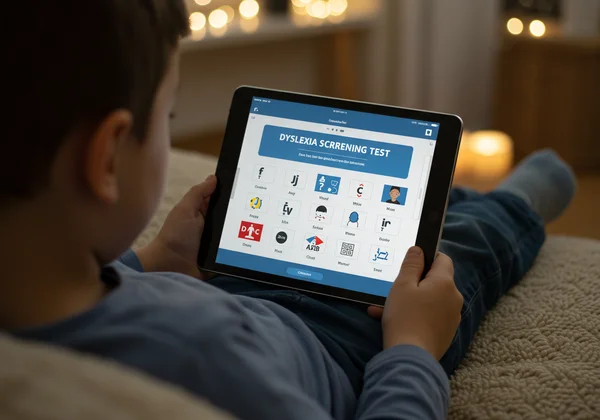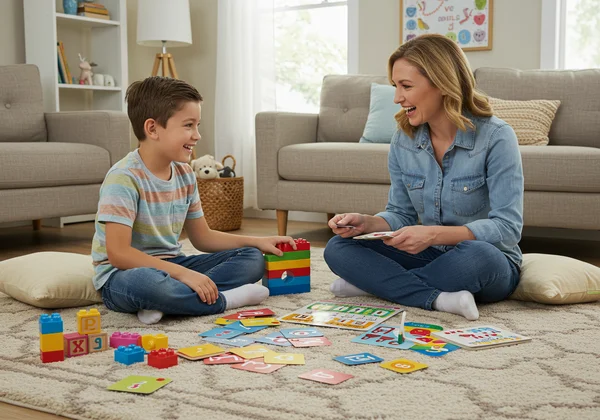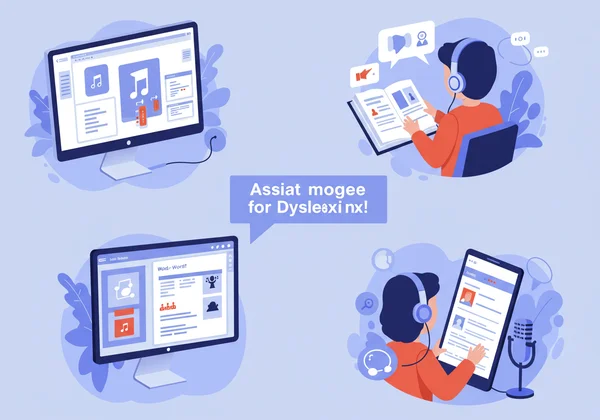How to Help a Child with Dyslexia: A Parent's Action Plan for Dyslexia Screening
Feeling overwhelmed by your child's reading struggles? You're not alone. Watching your bright, curious child have difficulty with words can be confusing and stressful. This guide offers a clear, step-by-step plan to help you confidently navigate this journey. We'll show you how to help a child with dyslexia, moving from initial concerns to effective, long-term support. The first step is understanding, so How to test for dyslexia? Let's start by exploring a simple, accessible screening that can unlock your child's full reading potential. You can take the first step right now.
Understanding Dyslexia & Your First Steps
Before you can act, you need clarity. This first phase is about understanding what dyslexia is—and isn't—and taking a crucial first step toward identifying potential challenges. This knowledge will empower you to become your child's best advocate.
What Exactly is Dyslexia? Dispelling Common Myths
Dyslexia is one of the most common learning differences, affecting the parts of the brain that process language. It's not a sign of low intelligence; in fact, many individuals with dyslexia are highly creative and intelligent. Let's bust some common myths:
- Myth 1: Dyslexia is just reversing letters. While some children with dyslexia may mix up 'b' and 'd', it's a small part of a much larger picture. The core issue lies in phonological awareness—the ability to recognize and work with the sounds in spoken language.
- Myth 2: Children with dyslexia just need to try harder. Dyslexia is a neurobiological difference. It requires different teaching methods, not more effort.
- Myth 3: Dyslexia will be outgrown. Dyslexia is a lifelong condition. However, with the right support and strategies, individuals with dyslexia can become successful readers and learners.
This understanding helps shift the focus from blame to genuine support—a vital step in fostering progress at home.
Recognizing the Early Signs: When to Consider a Screening
Parents are often the first to notice that something is amiss. While signs of dyslexia in a child can vary by age, some common red flags in school-aged children include:
- Difficulty learning the alphabet and connecting letters to their sounds.
- Trouble decoding or "sounding out" new words.
- Reading that is slow, choppy, and full of errors.
- Poor spelling skills and frequent, inconsistent spelling mistakes.
- Avoiding reading activities or expressing frustration when asked to read.
If these signs sound familiar, it doesn't automatically mean your child has dyslexia. However, it does signal that it’s time to look closer and gather more information. This is where an initial screening can be invaluable.
Taking the First Step: Free Online Dyslexia Screening
The thought of a formal evaluation can be daunting and expensive. A great first step is an accessible, preliminary screening. An online dyslexia test can provide initial insights into your child's risk level, helping you decide on the next steps. Our free screening tool is designed by educational psychologists to assess key areas like phonological awareness and decoding. It’s a fast, confidential way to get a clearer picture and receive actionable advice, all from the comfort of your home.

Navigating School Support: Advocating for Your Child
Once you have an initial understanding, the next step is to partner with your child's school. Supporting a dyslexic child effectively often involves a team effort between home and the classroom. Being a proactive and informed advocate is one of the most powerful roles you can play.
Effective Communication with Teachers and School Staff
Your child's teacher is your most important ally. Schedule a meeting to discuss your concerns. Be prepared to share specific examples of what you're observing at home. Bring the results from your online dyslexia quiz as a conversation starter. Ask the teacher what they have noticed in the classroom. Frame the conversation collaboratively: "How can we work together to support my child's reading?" This approach fosters a partnership focused on your child's success.

Understanding IEPs, 54 Plans, and Classroom Accommodations
If your child's reading challenges are significant, they may be eligible for formal support at school. An Individualized Education Program (IEP) or a 504 Plan are legal documents that outline the accommodations and services a school will provide. Common accommodations for dyslexia include:
- Extra time on tests and assignments.
- Access to audiobooks or text-to-speech software.
- Reduced homework loads or modified assignments.
- Multi-sensory instruction that uses sight, sound, and touch.
Research these options to understand what kind of school support for dyslexia is available and appropriate for your child's needs.
When to Seek a Formal Dyslexia Assessment
An online screening is a powerful first step, but it is not a diagnosis. If the screening indicates a potential risk and your concerns persist, it may be time to seek a formal dyslexia assessment. This comprehensive evaluation is conducted by a qualified professional, such as an educational psychologist. It provides a definitive diagnosis and detailed recommendations for intervention. This formal report is often necessary to qualify for an IEP or 504 Plan at school.
Creating a Supportive Home Environment for Learning
Make your home a safe haven where your child feels confident and truly supported. Fostering a positive learning environment is just as important as securing school accommodations. It's where you can build resilience and a love of learning that transcends any challenges.
Engaging Activities and Games to Boost Reading Skills
Turn skill-building into fun! Many dyslexia activities for kids don't feel like work at all. Play games that build phonological awareness, like rhyming games or "I Spy" with letter sounds. Read aloud to your child every day, choosing books that are interesting to them, even if they are above their reading level. This builds vocabulary, comprehension, and a positive association with stories. The goal is to make language and reading joyful, not a chore. You can find more dyslexia resources on our blog.

Building Confidence and Fostering a Growth Mindset
Children with dyslexia often struggle with self-esteem. They may feel "stupid" or "lazy" when they compare themselves to their peers. Your most important job is to nurture their confidence. Praise their effort, persistence, and creativity, not just their reading performance. Help them understand that their brain is simply wired differently and that this difference comes with unique strengths. This approach is the cornerstone of positive parenting dyslexia.
Essential Assistive Technology Tools for Dyslexia
Today, assistive technology for dyslexia is transforming how children learn. These tools can help level the playing field, allowing your child to access information and express their knowledge without being held back by reading or writing difficulties. Explore options like:
- Text-to-speech (TTS) software: Reads digital text aloud.
- Audiobooks: Allows them to enjoy stories and access grade-level content.
- Speech-to-text (dictation) software: Lets them write by speaking.
Many of these tools are free and readily available on computers and tablets, providing essential support for your child's learning journey.

Empowering Your Child's Journey: A Lifelong Action Plan
Supporting your child through dyslexia is a journey, not a quick fix. Your role as a parent is to be their guide, their advocate, and their biggest cheerleader. By following this action plan—understanding the signs, taking an initial screening, collaborating with the school, and creating a supportive home—you are paving the way for your child's success. You have the power to turn challenges into opportunities for growth and resilience.
Ready to take that crucial first step? Visit our site to take a free, confidential dyslexia screening today and unlock your child's true reading potential.
Frequently Asked Questions About Helping a Child with Dyslexia
How accurate is an online dyslexia screening test?
An online dyslexia screening test is a highly valuable preliminary tool. It's designed to identify potential risk factors and signs associated with dyslexia based on your answers. While it is not a formal diagnosis, a high-quality screening provides a strong indication of whether a professional evaluation is needed, serving as a critical first step. You can try our free tool to get started.
What are the signs of dyslexia in a 7-year-old that parents should look for?
At age 7, parents should look for difficulties with sounding out words, slow and effortful reading, confusion with small words like "at" and "to," and frequent spelling errors. They may also struggle to remember sequences like the days of the week or have trouble with rhyming. These are key indicators that a screening might be beneficial.
Can schools provide a formal diagnosis for dyslexia?
This varies by location and school district. Public schools can conduct evaluations to determine if a child has a "specific learning disability" to qualify for special education services (like an IEP). However, they may not always use the specific term "dyslexia." For a definitive clinical diagnosis, parents often need to seek a private evaluation from a qualified psychologist.
What is the typical cost of a comprehensive formal dyslexia assessment?
The cost of a formal dyslexia assessment can vary widely, often ranging from several hundred to a few thousand dollars, depending on the professional and the depth of the evaluation. This is why using a free and reliable online screening tool first is such a practical and cost-effective way to gauge the need for this significant investment.